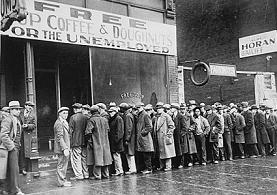Real, Uglier American Unemployment

Can you trust national averages? As bad as the jobless data you hear are, you have not been told the whole truth. If you think the terrible impact of America ’s Great Recession is shown by an official unemployment rate of about 10 percent, think again.
Economic inequality and the myth of Reagan trickle down logic are shown by new data from the Center for Labor Market Studies at Northeastern University in Boston . The report noted: “What has been missing from the public debate over the labor market crisis is an honest and detailed analysis of which American workers have been most adversely affected by the deep deterioration in labor markets.” The researchers found a correlation between household income and unemployment rate in the last quarter of 2009: Look carefully at these numbers and see how unemployment rises as income drops:
$150,000 or more, 3.2 percent
$100,000 to 149,999, 8 percent
$75,000 to $99,999, 5 percent
$60,000 to $75,000, 6.4 percent
$50,000 to $59,000, 7.8 percent
$40,000 to $49,000, 9 percent
$30,000 to $39,999, 12.2 percent
$20,000 to $29,999, 19.7 percent
$12,500 to $20,000, 19.1 percent
$12,499 or less, 30.8 percent
Ten times worse unemployment in the lowest class than in the highest class! Truly amazing and disheartening, don’t you think? And you can also infer that in some hard hit geographical areas the poorest people and people of color are being even more adversely impacted. And don’t think for a minute that things have really improved in 2010.
The report summed up the situation: “A true labor market depression faced those in the bottom…of the income distribution; a deep labor market recession prevailed among those in the middle of the distribution, and close to a full employment environment prevailed at the top.” People at the top remain winners no matter how bad the whole economy. Why? The wealthy Upper Class controls so much of the political system and benefit from countless government policies. They may lose something in an economic meltdown but not enough to suffer significantly.
Conversely, those at the bottom of the economic system with no political power are experiencing something as bad as the Great Depression, with no end in sight.
What pundits don’t emphasize is that government policies that do not target lower income groups are a failure and disgrace. Worse than destroying the middle class, we are creating a Lower Class like that found in third world countries. Indeed, compared to places like China and European nations, America ’s poor are suffering about as badly as anyone on the planet, except for a few dismal places like Haiti . Needing food handouts, losing homes, missing health insurance, and lacking jobs mock the American Dream.
Wait; there is even more bad news. When underemployment is factored in — part time workers that want to work full time, and those who have stopped looking but want a job — the picture gets even worse. In the lowest group, the underemployment rate was 20.6 percent, compared with just 1.6 percent in the highest group. So the total in the lowest class is 51.4 percent (3.7 million people) compared to 4.8 percent in the wealthy class (530,000 people). Also consider that last November nearly 20 percent of all men between 25 and 54 did not have jobs, the highest figure since the labor bureau began counting in 1948.
Now you know why the constantly noted official jobless rate for the nation of 10 percent and 17 percent when underemployment is counted are a joke, or is it a purposeful deception, like a truth bubble?
How can jobs be created for the lower economic classes? You hear very, very few new ideas from politicians. It comes down to federal spending that better targets job creation to the lower income groups, and waiting for more general consumer spending, especially by the more affluent, to create more low level jobs, mostly in service areas. But we need specifics and better legislation.
Consider this green energy fiasco. A huge amount of federal stimulus money provided for building wind farms. It is creating jobs in Chine to build wind turbines, not in America . In fact, 80 percent of such federal funding is going overseas. All because Congress and the White House did not ensure a made-in-America requirement. Was a backroom deal made to keep China happy so that they would keep loaning us money?
When the poorest people suffer so disproportionately as compared to the wealthiest, perhaps only violent revolution will fix America ’s dysfunctional, broken and delusional democracy. Will President Obama cite the above frightening data in any public forum to make the case for stronger federal efforts? What do you think?
The high numbers for the lower income people mean that no amount of government action, in even five years or more, will solve jobless problem, because no amount of economic growth can possibly create enough new jobs. The US would have to produce 10 million new jobs just to get back to the unemployment levels of 2007 – impossible for many years. So, politicians will keep making things look better by citing the national average.
Joel S. Hirschhorn can be reached through delusionaldemocracy.com.

